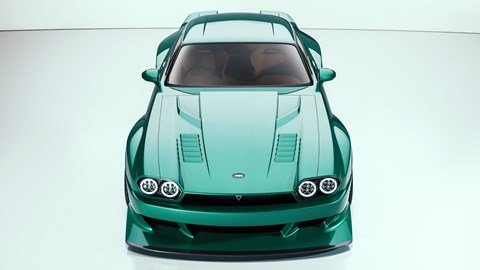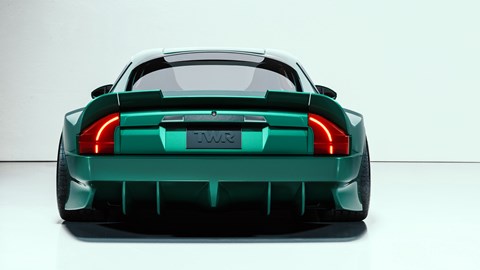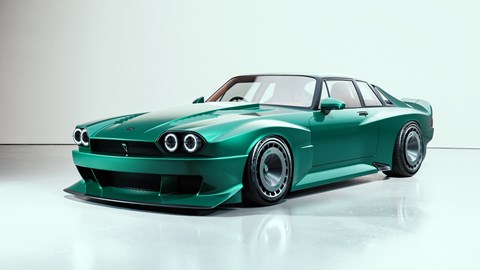► TWR is back with Supercat ‘Super-GT’
► Supercharged V12 and manual gearbox
► Design by @the_kyza and Magnus Walker
The names TWR and Jaguar go together like bread and jam – so it seems entirely appropriate that the reinvention of the former as a ‘constructor of bespoke automobiles’ begins with this TWR Supercat, which is based on the Jaguar XJS. Jaguar’s grand tourer, which will be 50 years old in 2025, has always been distinctive. But the Supercat is something else.
Clad in thoroughly rescultped carbonfibre bodywork and powered by a supercharged V12 that promises ‘more than 600bhp’, the Supercat is the new TWR’s first effort to claim a piece of the well-heeled restomod market. Its appearance is spectacular, but if it also looks a little like something you’d see on social media, digitally crafted by a genius with a computer, well, there’s a reason for that, too…
We need a bit of background here
The new TWR has been founded by Fergus Walkinshaw – son of Tom Walkinshaw, the TW in the original name (the R standing for Racing) – and business partner John Kane. It’s a ‘separate entity’ to the originally TWR, which built a legendary name for itself developing racing and performance cars in the 1980s and 1990s.
Much of that legend came in association with Jaguar, particular the XJR-9 and XJR-15 Le Mans cars. Though there were contemporary TWR versions of the XJS that raced as well, the Supercat’s limited run of 88 examples pays tribute to the XJR-9’s Le Mans victory in 1988. The TWR name may also be familiar for its racing link to other brands, most notoriously the Volvo 850 Estate touring car.

The firm’s reinvention as the creator of modernised classics has not come overnight. The Supercat project has been in the works for nearly three years and TWR’s team comprises ‘a group of technical and operational talent from the most celebrated names in motorsport and performance car development. This includes: McLaren, Ferrari, Porsche, Williams, Mercedes F1 and Renault F1.’
Furthermore: ‘The design, engineering and development programme of the Supercat series sets the standard for all future TWR products and production runs. The development of this project started more than two years ago and has taken hundreds of thousands of collective hours to get to its current production-ready state.’
Those hours have been spent honing aerodynamics, durability and dynamics at proving grounds the world over.
Any more details about the TWR Supercat itself?
Some. TWR describes it as a ‘Super-GT’, but there’s not much depth to the info about the supercharged V12 or any chassis changes under the skin. A manual gearbox has been confirmed.

Beyond that, all we really have at the moment are the words of Fergus Walkinshaw, who states: ‘We cannot wait for clients to experience the most powerful, dynamic and visceral evocation of a British icon that has been revolutionised from the ground-up to be ready for those that demand to be connected to the cars they drive, whether on the track or the road. This is the TWR way and will define this and every future project we undertake.’
But perhaps that’s because at this stage TWR wants us to focus on the design, which is certainly very striking. Those carbonfibre panels make the Supercat lighter and stronger than the XJS that donates its skeleton, and the overall development of the body is said to have taken ‘tens of thousands of hours’.
Who designed the TWR Supercat?
Underlining the very 21st century modernism of this project, the vehicle designer is none other than Khyzyl Saleem – someone who may be better known to some readers by his social media handle, @the_kyza – while Magnus Walker, of outlaw Porsche fame, is named as the design consultant.

Saleem is a self-taught concept artist with an enormous back catalogue of modified vehicle renders. Notable as someone with a definite style as well as obvious talent, his designs have been making their way into the real world for several years, with the Supercat now the ultimate expression of this transition.
The Supercat won’t be for everyone, but there are certainly plenty of petrolheads out there who will get it.
How much does it cost – and who are the rivals?
The basic price for a TWR Supercat is £225,000 – but that’s before tax and personalisation. UK buyers will be paying upwards of £270,000 before they get into paint, trim and standard equipment choices. TWR will reveal the ‘fundamentally re-imagined interior’ when the car makes its ‘dynamic debut’ in summer 2024.
From that we’d guess it’s probably going to be at the Goodwood Festival of Speed.
The use of ‘re-imagined’ there is mildly amusing, as on social media TWR has stated ‘this is no ‘reimagining,’ or ‘modern interpretation’ of a Jaguar XJS. It’s a TWR through and through.’
We’ll have to wait for more engineering details to see if there’s anything fundamentally different to support that claim, but for now its hard not to make comparisons to Singer – and all those other re-worked Porsche 911 merchants. Those looking for something different to the rear-engined experience are hardly underserved, either. Consider the Cyan Racing P1800, for instance, or the cars created by Alfaholics and Frontline, or the E-Type scene lead by Eagle – perhaps even the Aston Martin Valour. Still, it is fun to see something different. And the Supercat is certainly that. The order book is open now.